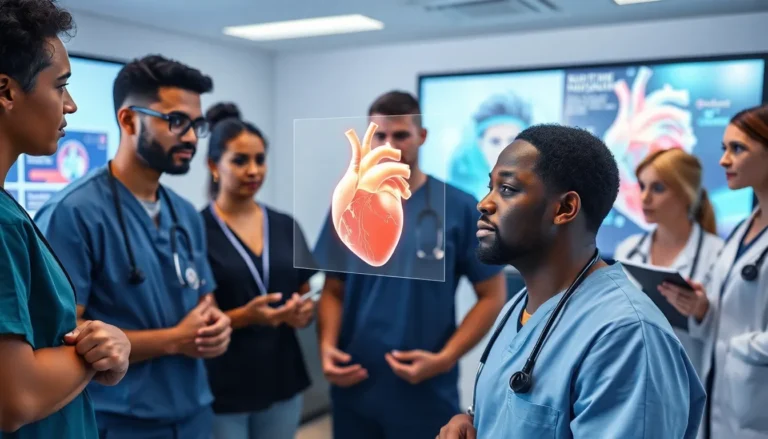Table of Contents
ToggleImagine a world where your fridge knows when you’re out of milk, your car drives itself, and your thermostat adjusts to your favorite temperature before you even walk in the door. Welcome to the magical realm of 5G Internet of Things (IoT), where everything around you is smarter, faster, and just a tad more sassy. With lightning-fast connectivity and ultra-reliable networks, 5G is the secret sauce that makes this futuristic dream a reality.
As 5G rolls out, it’s not just about faster downloads or smoother streaming. It’s about transforming everyday objects into intelligent allies that enhance our lives. From smart homes to connected cities, the possibilities are endless. Buckle up as we dive into the top five ways 5G IoT is set to revolutionize our world, making it more efficient, convenient, and maybe even a little more fun.
Overview of 5G Internet of Things
5G Internet of Things (IoT) represents a significant advancement in connectivity, allowing devices to communicate seamlessly and efficiently. This technology supports an extensive range of applications, from smart appliances in homes to scalable infrastructure in cities. Enhanced speed and reduced latency are two key features of 5G technology, enabling real-time communication between connected devices.
Significantly, 5G networks can support up to one million devices per square kilometer, allowing for a massive expansion of IoT networks. Sensors embedded in everyday objects will collect data, providing users with insights for better decision-making. Additionally, this connectivity fosters automation, making processes more efficient in industries such as healthcare, agriculture, and transportation.
Smart cities are a prime example of the potential for 5G IoT integration. Streetlights equipped with sensors can adjust brightness based on pedestrian activity. Traffic systems can optimize flow based on real-time data. This connectivity not only enhances urban living but also contributes to sustainability efforts.
Healthcare stands to benefit immensely from 5G IoT as well. Remote monitoring devices can deliver critical patient data to healthcare providers instantly, allowing for timely interventions. Wearable technologies can track health metrics, providing both users and professionals with invaluable information for preventative care.
Businesses will leverage 5G IoT to enhance operations. Automation and predictive analytics will boost productivity and reduce costs. Supply chains equipped with IoT solutions can monitor inventory levels dynamically, enabling better resource allocation.
Overall, 5G Internet of Things presents opportunities for innovation across various sectors, representing a transformational leap toward a more interconnected world.
Key Benefits of 5G Internet of Things

5G Internet of Things (IoT) offers several transformative benefits that enhance everyday experiences. Key advantages include enhanced connectivity and improved speed and latency.
Enhanced Connectivity
Enhanced connectivity enables seamless communication among devices. Millions of devices can connect simultaneously without network strain. This capability supports diverse IoT applications, from smart appliances to environmental sensors. Efficient data transmission ensures real-time interactions, allowing homes and cities to function intelligently. The integration of 5G technology empowers industries to implement scalable solutions, adapting to growth demands effectively.
Improved Speed and Latency
Improved speed dramatically affects user experiences. Data transfer rates can reach up to 10 Gbps, facilitating instant responses. Latency reductions, often below one millisecond, bring remarkable benefits for critical applications like remote surgery or autonomous vehicles. Quick responses correlate with better decision-making across various sectors. These advancements contribute to the overall productivity and responsiveness of businesses, creating more agile environments.
Applications of 5G Internet of Things
Numerous applications emerge from the integration of 5G Internet of Things. This technology drives innovations across various sectors, enhancing connectivity and efficiency.
Smart Cities
Smart cities utilize 5G IoT to streamline urban living. Connected streetlights improve energy efficiency and reduce maintenance costs. Traffic systems employ real-time data to optimize routes, minimizing congestion. Public safety also benefits; smart surveillance can monitor activities and respond swiftly. Enhanced connectivity fosters improved air quality via sensor data that helps in pollution control. All these advancements contribute to a sustainable urban environment.
Industrial Automation
Industrial automation sees significant improvements with 5G IoT. Factories use interconnected devices to monitor operations in real time. Predictive maintenance can prevent equipment failures, reducing downtime. Robotics benefit from enhanced communication, allowing for more precise coordination. Supply chains become more efficient with tracking systems, facilitating seamless logistics. Such transformations boost overall productivity and reduce operational costs.
Healthcare Innovations
Healthcare innovations stand out with the help of 5G IoT. Remote monitoring devices allow clinicians to track patient health without in-person visits. Wearable health technologies provide continuous data, enabling timely responses to health issues. Telemedicine becomes more effective thanks to lower latency, enhancing patient consultations. Hospitals benefit from improved asset management via IoT sensors tracking equipment availability. These advances ultimately lead to better patient outcomes and efficiency within healthcare systems.
Challenges Facing 5G Internet of Things
5G Internet of Things (IoT) faces several notable challenges that could impact its widespread adoption and functionality.
Security Concerns
Security remains a paramount concern in 5G IoT networks. Increased connectivity creates more entry points for potential cyberattacks. Hackers can exploit vulnerabilities in devices and networks, risking data privacy and system integrity. Moreover, the sheer number of connected devices complicates security protocols. Each device may lack robust security measures, making them easy targets. Organizations must prioritize implementing comprehensive security frameworks to protect sensitive data. Regular updates and patching reduce risks associated with vulnerabilities in connected devices.
Infrastructure Requirements
Infrastructure requirements pose another significant challenge. Deploying 5G networks involves substantial investment in new technology and infrastructure. Cities and regions must enhance existing networks to support dense connectivity. Fiber optic cables and advanced base stations are critical components for efficient network operations. In urban areas, space limitations complicate the installation of necessary infrastructure. Collaboration between public and private sectors is essential to address these challenges effectively. Achieving successful deployment relies on proper planning and resource allocation to meet the demands of a connected world.
Future of 5G Internet of Things
5G IoT technology promises to enhance everyday experiences by creating a seamless network of connected devices. Increased connectivity leads to improved efficiency in smart homes and urban environments. Significant advancements in communication enable real-time data exchange, allowing devices to respond instantly to user needs.
Smart transportation systems take center stage as cities adopt 5G IoT solutions. Intelligent traffic management systems can analyze real-time data, reducing congestion and improving travel times. Similarly, connected vehicles benefit from lower latency, allowing for safer navigation and enhanced driver assistance features.
Healthcare innovations are also on the horizon, with remote patient monitoring becoming mainstream. Wearable devices transmit health data to medical professionals instantly, enabling proactive care solutions and minimizing emergency situations. Hospitals will leverage 5G IoT for asset tracking, optimizing resource usage and enhancing patient outcomes.
Businesses are set to experience operational transformations. Automation combined with predictive analytics provides insights for improving productivity and resource management. Factories equipped with interconnected machines will experience heightened efficiency, reducing downtime through real-time monitoring.
Challenges remain in the path toward widespread 5G IoT adoption. Security concerns continue to escalate as the number of connected devices grows. Implementing robust security frameworks becomes essential to protect sensitive data from potential breaches.
Infrastructure investments pose additional hurdles. Upgrading existing networks to handle 5G demands financial commitment and collaboration between public bodies and private entities. Emphasizing strategic partnerships will facilitate successful deployments, ensuring that cities and businesses fully realize the capabilities of 5G IoT technology.
The evolution of 5G Internet of Things technology is set to redefine how individuals and communities interact with their environments. As smart devices become more integrated into daily life enhanced connectivity and improved efficiency will lead to unparalleled convenience.
While the benefits of 5G IoT are substantial the challenges cannot be overlooked. Addressing security concerns and investing in necessary infrastructure will be crucial for realizing the full potential of this transformative technology.
With continued innovation and collaboration among stakeholders the future of 5G IoT holds significant promise for smarter living and improved quality of life.







